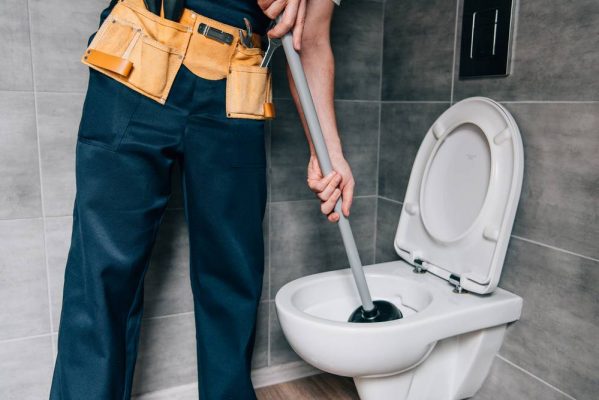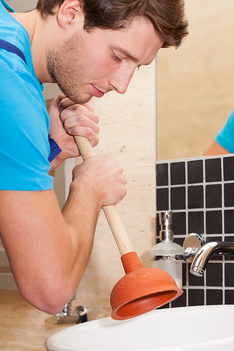Applying Plunger and Drain Cleaner: Effective Techniques
Applying Plunger and Drain Cleaner: Effective Techniques
Blog Article
What're your opinions regarding How To Use Your Toilet Plunger Correctly in 5 Easy Steps?

Intro
Proper maintenance of home drains is vital for stopping obstructions and making certain smooth water circulation. Among the secret tools in every home owner's toolkit is the plunger, alongside different drain cleaners made to tackle stubborn blockages properly. This post explores just how to use bettors and drain cleansers successfully to keep your drains pipes flowing openly.
Section 1: Recognizing Plungers
Sorts of Plungers
There are several sorts of plungers offered, each designed for different sorts of drains pipes and blocks. One of the most common types consist of mug plungers, flange plungers, and accordion bettors.
Just How Plungers Job
Plungers deal with the concept of developing stress and suction to dislodge blockages. When appropriately used over a drainpipe, they develop a vacuum that can pull out debris or break up blockages.
Choosing the Right Plunger
Choosing the best plunger depends upon the type of drain and the nature of the blockage. Cup plungers are perfect for sinks and tubs, while flange plungers are better suited for bathrooms as a result of their style.
Typical Mistakes with Bettors
Staying clear of these mistakes guarantees reliable plunging: improper seal around the drain, not enough force, and not clearing bordering debris.
Area 2: Using Plungers Successfully
Prep work
Before diving, ensure the plunger covers the drainpipe entirely and forms a tight seal. Clear any kind of noticeable debris around the drain opening.
Method
Begin with mild diving activities to build suction. Increase pressure slowly, utilizing a consistent rhythm. Repeat as essential till the drainpipe gets rid of.
Repairing Tips
If diving does not function, try changing the seal, applying petroleum jelly for a better seal, or using a various type of plunger.
Section 3: Understanding Drain Cleansers
Kinds Of Drainpipe Cleaning Company
Drain pipes cleansers can be chemical or chemical. Chemical cleansers utilize solid chemicals to liquify clogs, while enzymatic cleaners use all-natural enzymes to break down raw material.
Exactly How Drain Cleaners Work
Chemical cleansers respond with blockages to dissolve them, while chemical cleansers break down organic materials like hair and grease without damaging pipelines.
Safety and security Considerations
Always put on gloves and eye protection when utilizing chemical drainpipe cleansers. Make sure adequate air flow and adhere to maker directions carefully.
Eco-Friendly Alternatives
Think about making use of vinegar and cooking soft drink or enzyme-based cleaners for environmentally friendly choices that are much safer for pipes and the atmosphere.
Section 4: Using Drain Cleaners Effectively
Application Strategies
Put chemical cleaners directly into the drainpipe opening. Enable them to help the recommended time prior to purging with hot water. Chemical cleansers ought to rest over night.
Precautions
Stay clear of mixing different kinds of cleaners, as this can generate harmful fumes. Never ever make use of chemical cleansers in conjunction with a plunger, as splashing can occur.
Dealing With Persistent Obstructions
For relentless obstructions, think about utilizing a pipes serpent or calling an expert plumbing technician to avoid damage to pipelines.
Final thought
In conclusion, understanding just how to utilize plungers and drainpipe cleaners efficiently is crucial for preserving healthy pipes systems. By selecting the right devices and strategies, home owners can tackle small obstructions and avoid major pipes concerns down the line.
How To Properly Use A Plumbing Snake To Clear Drains
When any drain clogs in our home arise, we tend to gravitate toward the plunger and little else. In cases where the plunger and its vacuum-created pressure are not able to clear clogs, many immediately move to harmful chemicals or simply call their plumber to fix the issue.
we’re happy to help with all drain cleaning needs and concerns. This includes informing you on a few other home remedies you may have at your disposal for minor to moderate clogs, one of which is the use of a plumbing snake. Many people have never used one of these before – let’s go over the steps to take when your drain clogs and you have a plumbing snake available.
Attempt Plunger Use
The first step here, as we noted above, should indeed be to grab your plunger when you notice a drain clog and attempt to resolve it this way. If you’re unsure how to use a particular type of plunger, our plumbers can answer any questions you have. If this doesn’t do the trick, however, you move on to the snake.
Locate And Prepare Snake
A plumbing snake is a metal or plastic device that’s generally about a quarter of an inch thick. It’s design with significant extensions, meant to reach down into your clogged drain and push the clog out. Snakes also contain drain augers that will latch onto and push stubborn blockages.
If your plunger doesn’t clear a clog, locate your snake and bring it to the drain in question. We also recommend keeping a bucket nearby to collect the clog once you pull it out, plus we’d advise wearing goggles and possibly protective gloves.
Feed Snake
Once you’re ready to go, feed the snake slowly down the drain, using the crank device it comes with to keep it moving until it finds the clog. Once this happens, much of the clog will be latched onto the coil so you can pull it out, while the rest will simply break up and flow downward.
Detach Debris
Remove the snake slowly from the drain, and once you’ve done so, pick off any debris that’s stuck to the coil. This is another area where wearing gloves is a must.
Flush Drain
Finally, take a few minutes to ensure the snake has done its job correctly. If you’ve been using it on a toilet, flush the toilet a couple times and make sure everything flows well. If you’ve used it on a different drain, flush it with some room temperature water.
https://www.mybuddytheplumber.com/blog/how-to-properly-use-a-plumbing-snake-to-clear-drains/

Application Strategies
Put chemical cleaners directly into the drainpipe opening. Enable them to help the recommended time prior to purging with hot water. Chemical cleansers ought to rest over night.
Precautions
Stay clear of mixing different kinds of cleaners, as this can generate harmful fumes. Never ever make use of chemical cleansers in conjunction with a plunger, as splashing can occur.
Dealing With Persistent Obstructions
For relentless obstructions, think about utilizing a pipes serpent or calling an expert plumbing technician to avoid damage to pipelines.
Final thought
In conclusion, understanding just how to utilize plungers and drainpipe cleaners efficiently is crucial for preserving healthy pipes systems. By selecting the right devices and strategies, home owners can tackle small obstructions and avoid major pipes concerns down the line.
How To Properly Use A Plumbing Snake To Clear Drains
When any drain clogs in our home arise, we tend to gravitate toward the plunger and little else. In cases where the plunger and its vacuum-created pressure are not able to clear clogs, many immediately move to harmful chemicals or simply call their plumber to fix the issue.
we’re happy to help with all drain cleaning needs and concerns. This includes informing you on a few other home remedies you may have at your disposal for minor to moderate clogs, one of which is the use of a plumbing snake. Many people have never used one of these before – let’s go over the steps to take when your drain clogs and you have a plumbing snake available.
Attempt Plunger Use
The first step here, as we noted above, should indeed be to grab your plunger when you notice a drain clog and attempt to resolve it this way. If you’re unsure how to use a particular type of plunger, our plumbers can answer any questions you have. If this doesn’t do the trick, however, you move on to the snake.
Locate And Prepare Snake
A plumbing snake is a metal or plastic device that’s generally about a quarter of an inch thick. It’s design with significant extensions, meant to reach down into your clogged drain and push the clog out. Snakes also contain drain augers that will latch onto and push stubborn blockages.
If your plunger doesn’t clear a clog, locate your snake and bring it to the drain in question. We also recommend keeping a bucket nearby to collect the clog once you pull it out, plus we’d advise wearing goggles and possibly protective gloves.
Feed Snake
Once you’re ready to go, feed the snake slowly down the drain, using the crank device it comes with to keep it moving until it finds the clog. Once this happens, much of the clog will be latched onto the coil so you can pull it out, while the rest will simply break up and flow downward.
Detach Debris
Remove the snake slowly from the drain, and once you’ve done so, pick off any debris that’s stuck to the coil. This is another area where wearing gloves is a must.
Flush Drain
Finally, take a few minutes to ensure the snake has done its job correctly. If you’ve been using it on a toilet, flush the toilet a couple times and make sure everything flows well. If you’ve used it on a different drain, flush it with some room temperature water.
https://www.mybuddytheplumber.com/blog/how-to-properly-use-a-plumbing-snake-to-clear-drains/

I came across that blog posting about while looking around the internet. Loved our write-up? Please share it. Let others discover it. I treasure reading our article about How To Use Your Toilet Plunger Correctly in 5 Easy Steps.
Details Report this page